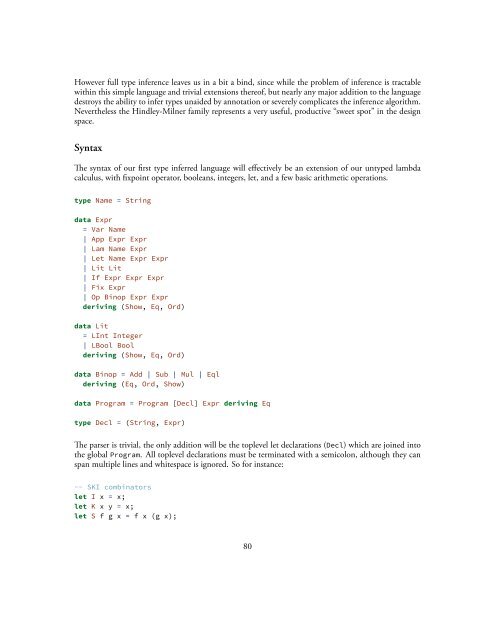You also want an ePaper? Increase the reach of your titles
YUMPU automatically turns print PDFs into web optimized ePapers that Google loves.
However full type inference leaves us in a bit a bind, since while the problem of inference is tractable<br />
within this simple language and trivial extensions thereof, but nearly any major addition to the language<br />
destroys the ability to infer types unaided by annotation or severely complicates the inference algorithm.<br />
Nevertheless the Hindley-Milner family represents a very useful, productive “sweet spot” in the design<br />
space.<br />
Syntax<br />
e syntax of our first type inferred language will effectively be an extension of our untyped lambda<br />
calculus, with fixpoint operator, booleans, integers, let, and a few basic arithmetic operations.<br />
type Name = String<br />
data Expr<br />
= Var Name<br />
| App Expr Expr<br />
| Lam Name Expr<br />
| Let Name Expr Expr<br />
| Lit Lit<br />
| If Expr Expr Expr<br />
| Fix Expr<br />
| Op Binop Expr Expr<br />
deriving (Show, Eq, Ord)<br />
data Lit<br />
= LInt Integer<br />
| LBool Bool<br />
deriving (Show, Eq, Ord)<br />
data Binop = Add | Sub | Mul | Eql<br />
deriving (Eq, Ord, Show)<br />
data Program = Program [Decl] Expr deriving Eq<br />
type Decl = (String, Expr)<br />
e parser is trivial, the only addition will be the toplevel let declarations (Decl) which are joined into<br />
the global Program. All toplevel declarations must be terminated with a semicolon, although they can<br />
span multiple lines and whitespace is ignored. So for instance:<br />
-- SKI combinators<br />
let I x = x;<br />
let K x y = x;<br />
let S f g x = f x (g x);<br />
80


